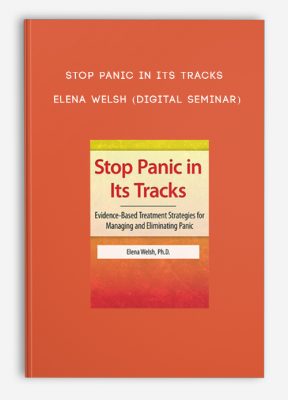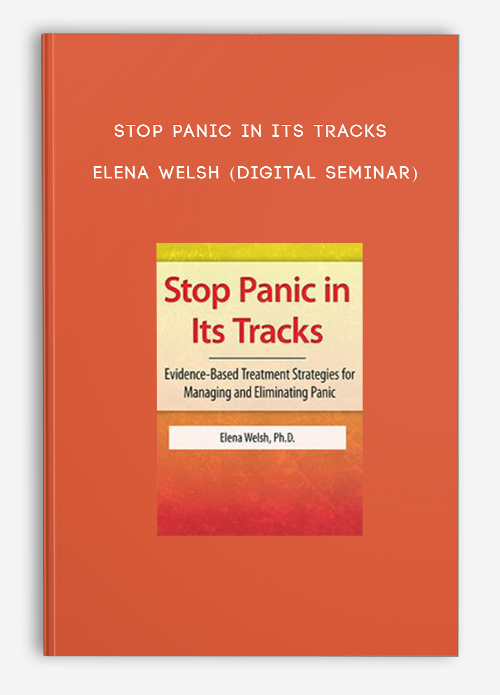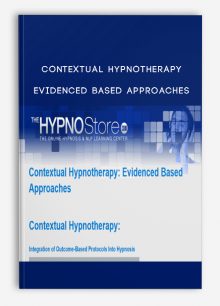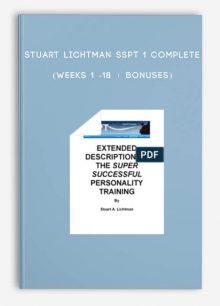Stop Panic In Its Tracks – ELENA WELSH (Digital Seminar)
$219.00 $65.00

Stop Panic In Its Tracks – ELENA WELSH (Digital Seminar)
Sale Page
Get Stop Panic In Its Tracks – ELENA WELSH (Digital Seminar) on Salaedu.com
Description:
Clients who are experiencing panic want relief from their suffering. And given that it took a mountain of courage just to show up at your door, you want to help them as quickly and effectively as you can. But without proper training, panic attacks can be very confusing and difficult to treat. It is very common that well-intentioned therapists inadvertently reinforce avoidance or escape behaviors, thereby prolonging recovery, worsening symptoms—leading to client drop out.
Watch anxiety expert and author, Elena Welsh, Ph.D., as she shares her treatment secrets that consistently improve the lives of her clients suffering from panic and anxiety. Using the best techniques from Acceptance and Commitment Therapy (ACT), mindfulness, and Cognitive Behavioral Therapy (CBT), Dr. Welsh lays out practical, step-by-step integrated treatment strategies that you can use right away, including how to:
- Differentiate diagnostically between panic disorder and panic attacks
- Provide psychoeducation that is non-pathologizing and immediately useful for clients
- Empower clients to increase their comfort level and accept difficult/distressing thoughts, feelings, and sensations
- Teach clients to preemptively catch and reframe thoughts that fuel anxiety and panic
- Motivate clients to shift behaviors to reduce the severity and frequency of panic/fear reactions
- Guide clients through exposure protocols to manage panic/fear reactions
- Manage your own anxiety about treating panicked and anxious clients
Do not let another client walk out that door wondering if they could live without panic and anxiety.
Purchase today!
Outline:
Assessment: Accurately Diagnose Panic and Anxiety Disorders
- Panic disorder vs. panic attacks that are secondary to other anxiety disorders
- Psychosocial factors that may exacerbate panic symptoms
- Impact on client’s social and occupational functioning
- Is the client’s support system inadvertently reinforcing panic symptoms?
INTEGRATING ACT, CBT, & MINDFULNESS INTO YOUR THERAPEUTIC TOOLBOX
Psychoeducation: The Essential Foundation of Anxiety Treatment
- Teach clients about the physiology of fearand avoidance in a non-pathologizing manner
- When the body is behaving normally, just at the wrong time!
- Physical sensations that comprise a panic attack
- How short-term relief (avoidance, distraction, etc) isn’t enough to yield long-term wellness
- Teach clients ‘the why’ of exposure before going through it
Cognitive Behavior Therapy (CBT): Target Cognitive Distortions that are Common in Anxiety
- Catastrophizing, jumping to conclusions, tunnel vision, emotional reasoning, and overgeneralization
- Tools to help clients gain awareness of and reframe distorted thinking
- Disrupt the link between thoughts and unhelpful/avoidance/escape behaviors
- Help clients critically examine the beliefs they hold about panic and its aftermath
Exposure Techniques: Breaking the Anxiety and Panic Cycle
- The importance of client buy-in for exposure to be effective
- How to develop graduated exposure plan
- Subjective Units of Distress (SUDs) ratings to improve clinician-client communication
- In-vivo vs. imaginal exposure
- The importance of remaining in an exposure exercise until fear subsides
- Modify exposure for telehealth
Acceptance and Commitment Therapy (ACT): Teaching Clients to “Drop the Rope”
- Values clarification
- Use of metaphors
- Exercises to increase comfort with difficult emotions and sensations
Tools for Calming the Body in the Midst of Panic
- Breathing skills to interrupt worry thoughts and slow down physiological panic symptoms
- Relaxation techniques to reduce vulnerability to panic
- Grounding techniques to lower the intensity
- How a daily mindfulness practice can reduce panic
Recovery Maintenance Tools: Make Sure Therapy is Working and Help Clients Stay on Track
- Individualized methods of tracking success and challenges
- Help clients maintain consistent skills practice and reduce avoidance behaviors
- Maintain a panic attack progress tracking tool
- Connect treatment to client’s goals and values
Other Clinical Considerations
- Anxiety and panic during challenging times
- Increased anxiety rates during public health crisis
- Complicating factors of hypochondriasis and panic disorder
- Limitations of the research and potential risks
NLP online course
So what is NLP?
NLP stands for Neuro-Linguistic Programming. Neuro refers to your neurology;
Linguistic refers to language; programming refers to how that neural language functions.
In other words, learning NLP is like learning the language of your own mind!
NLP is the study of excellent communication–both with yourself, and with others.
It was developed by modeling excellent communicators and therapists who got results with their clients.
NLP is a set of tools and techniques, but it is so much more than that.
It is an attitude and a methodology of knowing how to achieve your goals and get results
More Course: NLP – HYPNOSIS – PHILOSOPHY
Outstanding Course:Carole Doré – Power V and Contemplation
1 review for Stop Panic In Its Tracks – ELENA WELSH (Digital Seminar)
Add a review Cancel reply
Related products
HYPNOSIS - NLP Courses
HYPNOSIS - NLP Courses










king –
We encourage you to check Content Proof carefully before paying.
“Excepted” these contents: “Online coaching, Software, Facebook group, Skype and Email support from Author.”
If you have enough money and feel good. We encourage you to buy this product from the original Author to get full other “Excepted” contents from them.
Thank you!